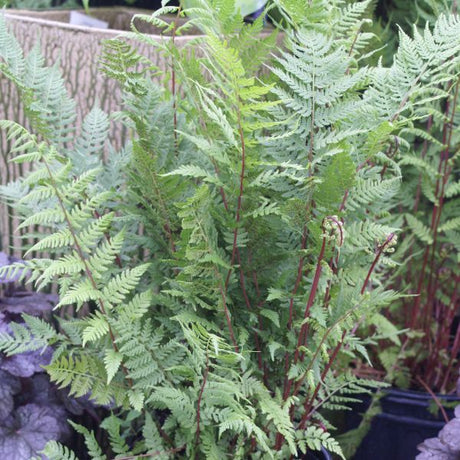-
Up to 33% off
-
Up to 24% off
-
Dryopteris erythrosora 'Brilliance'
Regular price From $1699Unit price /Unavailable -
Athyrium niponicum var. pictum 'Burgundy Lace'
Regular price $3700Unit price /Unavailable -
-
Adiantum aleuticum 'Five Finger'
Regular price $3429Unit price /Unavailable -
-
-
Godzilla Japanese Painted Fern
Athyrium 'Godzilla'
Regular price From $1699Unit price /Unavailable -
-
Dryopteris filix-mas undulata 'Robusta'
Regular price $3426Unit price /Unavailable -
-
-
-
-
Fantastic Ferns At Nature Hills Nursery
Ferns are an ancient plant with origins dating back to prehistoric times! There are about 12,000 types of Ferns, classified into about 40 different families around the world, and they grow in a wide range of climates and conditions.
Primordial vascular plants, Ferns do not have seeds or flowers as they reproduce via spores, known as Sori. Ferns are the second-most diverse group of vascular plants on earth!
Largely heavily dissected leaves are arranged in sword-like, triangular, or long spear-like fronds that are usually finely divided further into smaller sections called pinnae. The Sori form on the backsides of these fronds, forming small circles that start green or yellow and turn into fuzzy brown speckles.
Typically growing in humid, tropical environments, many native Ferns and native cultivars are also wonderfully cold-hardy!
After a Fern is established, it is relatively easy to grow! Ferns grow slowly to fast, but they are all very long-lived. Predominantly pest, disease-free, as well as deer and rabbit-resistant, Ferns have cemented themselves as landscape standards!

Landscaping With Ferns
Ferns are generally known as fantastic shade-loving landscape plants! They are also used as houseplants, and their cut foliage is especially useful in floral arrangements.
Smaller Ferns, 2 feet and under, are lacy and elegant edging, borders, front-of-the-garden accents, and fantastic container fillers and spillers!
Taller Ferns like Ostrich Fern and Western Sword Ferns are great back-of-the-border plants, backdrops, and lush seasonal screening! Planted in containers, they become wonderful thrillers and feature plantings!
All Ferns do great in all styles and types of gardens, many varieties spreading and naturalizing to create verdant drifts of fine-textured greenery, while others form vase-shaped clumps and fountains of elegant finery as specimens and focal points.
Low- maintenance enough to use en masse, you will love the cooling, refreshing presence as these airy plants fill the dappled shade and understory gloom! Plant in out-of-the-way woodland gardens and wildlife settings.
For the biggest impact, look no further than the Painted Ferns like Burgundy Lace or Jurassic Gold for the showiest foliage colors that go beyond the usual greenery!
Caring For Ferns
Shady landscapes or shady areas are the preferred locations where Ferns grow, handling full shade and morning sun only in hot climates, but more sun to dappled shade in cooler climates. Most prefer to be protected from the direct sun and wind and need a well-drained location, and they should be well supplied with consistent moisture.
Ferns prosper in rich organic soils. If the soil is average or poor, add lots of compost and organic matter. A generous layer of arborist mulch helps retain soil moisture, as well as insulate the root system from heat and chill.
Ferns do not require lots of attention. Prune dead or damaged fronds when they appear. Ferns are perennial, and in colder climates, they may die back to ground level in the winter and regrow each spring. You can also divide your clumps every few years to maintain their growing vigor.
Feathery Ferns Now Available For You!
If you have a shady location in your yard, then you need to include the graceful beauty and refreshing greenery that only a Fern can impart on the landscape!
Find which Ferns do best for your growing zone by entering your Zip Code in the zone finder in the plant highlights section, then select your new favorite garden specimens and filler!
FAQ's for Buying Ferns Online
What are the best ferns to grow in shady gardens?
What are the best ferns to grow in shady gardens?
Ferns thrive in shade to dappled sun, making them perfect for woodland gardens, understory plantings, and cool, moist spots in the landscape. Popular shade-loving varieties include the Ostrich Fern, Western Sword Fern, Japanese Painted Fern, and Lady Fern. These varieties are ideal for filling dark corners with lush, textured greenery.
Can ferns grow in containers or as houseplants?
Can ferns grow in containers or as houseplants?
Yes! Many compact ferns like Maidenhair Ferns or Boston Ferns do beautifully in containers or as indoor houseplants. Use them as thrillers or spillers in pots, or place them indoors in bright, indirect light. With consistent moisture and humidity, container-grown ferns add soothing texture and natural air purification to your home.
Do ferns come back every year?
Do ferns come back every year?
Most hardy ferns are perennials and return each spring in USDA Zones 3 through 9. In colder climates, they die back in winter and regrow from their root crowns. With proper care, these long-lived plants form clumps or spreading colonies, offering year-after-year beauty in shady borders, mass plantings, or native gardens.
How do I care for ferns in the landscape?
How do I care for ferns in the landscape?
Ferns prefer rich, well-drained soil with high organic content. Plant them in shady or partially shaded areas, water consistently to maintain even moisture, and mulch generously to protect the roots. Ferns are generally low-maintenance, deer-resistant, and disease-free. Prune dead fronds and divide clumps every few years to keep them vigorous.
Are there colorful fern varieties for ornamental appeal?
Are there colorful fern varieties for ornamental appeal?
Yes! While many ferns are known for their classic green fronds, some varieties bring bold foliage color to your garden. Look for Japanese Painted Ferns like 'Burgundy Lace' or Jurassic Gold Ferns for silvery, purple, or golden hues that stand out in shaded beds and containers. These showy ferns add unique flair beyond traditional greenery.






































